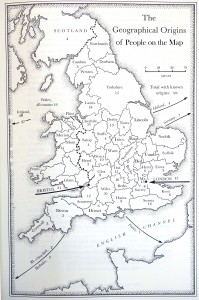When the English Quakers came over in fifty boats in 1682 and 1683 they settled in Philadelphia and in an arc of rural townships, from Chester County through Philadelphia County and eastward to Bucks County. Abington township lay in the middle of this arc. It was good farmland, well-watered by streams and creeks, and not too far from Philadelphia, an important feature for farmers who might take their surplus to the market to sell. It was also the seat of Abington Monthly Meeting, one of the earliest, largest, and most influential of the Quaker meetings.
Abington was typical of the townships settled early by English Quakers. It was not a “linear village” like Germantown or a proprietary manor like Springfield. It was not owned by a single purchaser like Nicholas More’s Manor of Moreland, nor was it dominated like a single family like the Growdens in Bensalem. Instead Abington, like many townships in lower Bucks and Chester Counties, was cut up into tracts for the first purchasers, most of whom bought their land in England from William Penn in 1681. At first the land in the township was owned by these early purchasers, but as the years passed, it was divided into smaller tracts. Some of the early purchasers did not settle on their tracts, but bought them as speculation. They settled instead on lots in the city, if they came to Pennsylvania at all. Of those who immigrated, some lived on their city lots; some sold them and lived in the country. As we will see, the early owners of Abington were a mix of immigrants and speculators.
The township was not originally called Abington. When Thomas Holme made his map in 1687, it had no name. In early deeds it was described as “the county of Philadelphia” or sometimes “Pemmapecca” (by any of several creative spellings). Holme drew a dotted line across his map dividing it into a northern and southern half, suggesting that it was originally meant to be two townships. The upper half was sometimes called Hilltown, and the lower half was sometimes called Dublin. When the township boundaries were finally laid out, Abington was formed from Hilltown and the northern part of Dublin, while the remainder of Dublin became Lower Dublin.[1] Abington township is quite large compared to other townships, over 10,000 acres. It touches Cheltenham, Upper Dublin, Moreland, and Lower Dublin, and touches (or almost touches) Springfield, Horsham and Oxford at the corners.
Pennypack Creek flows south through much part of Abington, crossing from Moreland and flowing south and southeast on its way to Lower Dublin and the Delaware River. It is a strong flowing stream and in the 1700’s was dotted with mills. Frankford or Tacony Creek also flows through Abington, on a path parallel to the Poquessing and west of it, through Cheltenham and so down to the Delaware. One large tract in the middle of Abington, originally Sarah Fuller’s land, had streams that drained into both the Frankford and the Poquessing Creeks.
Who were the first purchasers in Abington? They were an interesting mix—Wasey the sea captain captured by Barbary pirates, Clarridge the Irish lecher, Lehnmann the careless secretary, Mary Brodwell the midwive who lived to be a hundred, Elizabeth Shorter the glover, John Rush her deceitful son-in-law, the good Quaker farmers and the sharp-dealing Quaker merchants. By studying early records—land deeds, Penn’s letters, minutes of the Council, and more—we can find the stories hidden behind the names on the map. The next post will begin to tell those stories.
[1] The township of Upper Dublin lies north of Abington and, confusingly, does not touch Lower Dublin. The two Dublins were not derived from subdivision of one township, and currently lie in two different counties. When Montgomery County was split from Philadelphia County in 1784, the county line was run between Abington (in Montgomery) and Lower Dublin (in Philadelphia).

